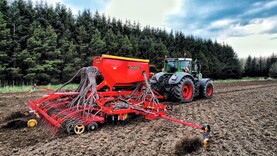With the increasing scrutiny on the emission profile of Irish agriculture, farmers must be armed with the facts and figures for their sector.
Agriculture greenhouse gas (GHG) emissions now account for 32% of national emissions. As a result, agriculture must reduce emissions of CH4 (methane), N2O (nitrous oxide) and CO2 (carbon dioxide) by 10% to 17.5Mt to 19Mt CO2e and deliver carbon sequestration of 10% (2.7 MT CO2e) by 2030.
The tillage sector stacks up extremely well in the face of these emissions, accounting for just 8% of agricultural emissions (2.56% of national emissions).
Within the sector’s emission profile, animals on tillage enterprises represent the main source of GHGs. However, that doesn’t exempt the sector from having to contribute to both our reduction and sequestration targets.
Positive on carbon
Grain production in Ireland has a low carbon footprint, ranging from 0.3kg to 0.6kg of CO2e per kg grain for our main crops.
In terms of carbon uptake, speaking at the recent National Tillage Conference, Teagasc’s Dermot Forristal explained that the average net uptake of all crops in Ireland is around 2.84t carbon/ha.
The net carbon uptake of winter oilseed rape between February and July was actually 5.3t/ha
However, in his presentation which explored the GHG emissions of oilseed rape establishment, he explained that the net carbon uptake of winter oilseed rape between February and July was actually 5.3t/ha.
When the crop is harvested, around 2.46t/ha of carbon is exported. However, 2.84t/ha of carbon remains in the residue and roots in the field.
This figure was based off six months of growth. However, winter oilseed rape can remain in the ground for up to 11 months, so potentially these figures on carbon could be even greater. The deep established root system also helps alleviate soil compaction.
The crop is also well documented to provide a number of benefits for biodiversity including forage for pollinators including honeybees, bumblebees, solitary bees and hoverflies.
Establishment
Trial work looked at the GHG emissions of non-plough systems versus disturbance tillage systems (min-till and strip-till systems) when establishing oilseed rape.
Overall, non-plough systems resulted in reduced soil carbon loss at cultivation. However, there was little difference in cumulative CO2 losses when compared with the other systems.
N2O losses were greater with low-disturbance tillage systems, due to slightly higher soil moistures, but emissions were low.
Read more
Launch of new Corteva fungicide Inatreq delayed until 2021
With the increasing scrutiny on the emission profile of Irish agriculture, farmers must be armed with the facts and figures for their sector.
Agriculture greenhouse gas (GHG) emissions now account for 32% of national emissions. As a result, agriculture must reduce emissions of CH4 (methane), N2O (nitrous oxide) and CO2 (carbon dioxide) by 10% to 17.5Mt to 19Mt CO2e and deliver carbon sequestration of 10% (2.7 MT CO2e) by 2030.
The tillage sector stacks up extremely well in the face of these emissions, accounting for just 8% of agricultural emissions (2.56% of national emissions).
Within the sector’s emission profile, animals on tillage enterprises represent the main source of GHGs. However, that doesn’t exempt the sector from having to contribute to both our reduction and sequestration targets.
Positive on carbon
Grain production in Ireland has a low carbon footprint, ranging from 0.3kg to 0.6kg of CO2e per kg grain for our main crops.
In terms of carbon uptake, speaking at the recent National Tillage Conference, Teagasc’s Dermot Forristal explained that the average net uptake of all crops in Ireland is around 2.84t carbon/ha.
The net carbon uptake of winter oilseed rape between February and July was actually 5.3t/ha
However, in his presentation which explored the GHG emissions of oilseed rape establishment, he explained that the net carbon uptake of winter oilseed rape between February and July was actually 5.3t/ha.
When the crop is harvested, around 2.46t/ha of carbon is exported. However, 2.84t/ha of carbon remains in the residue and roots in the field.
This figure was based off six months of growth. However, winter oilseed rape can remain in the ground for up to 11 months, so potentially these figures on carbon could be even greater. The deep established root system also helps alleviate soil compaction.
The crop is also well documented to provide a number of benefits for biodiversity including forage for pollinators including honeybees, bumblebees, solitary bees and hoverflies.
Establishment
Trial work looked at the GHG emissions of non-plough systems versus disturbance tillage systems (min-till and strip-till systems) when establishing oilseed rape.
Overall, non-plough systems resulted in reduced soil carbon loss at cultivation. However, there was little difference in cumulative CO2 losses when compared with the other systems.
N2O losses were greater with low-disturbance tillage systems, due to slightly higher soil moistures, but emissions were low.
Read more
Launch of new Corteva fungicide Inatreq delayed until 2021






 This is a subscriber-only article
This is a subscriber-only article









SHARING OPTIONS: